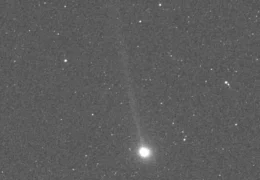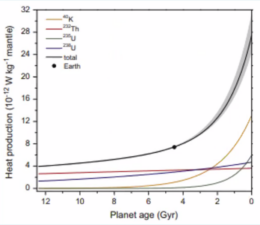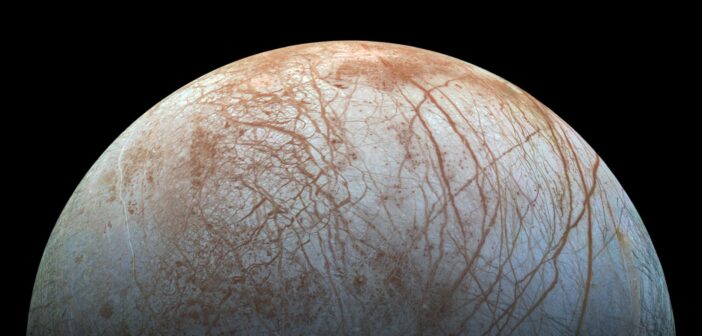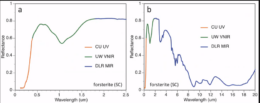Editor’s Note: This week we’ll be writing updates on selected events at the 56th Division for Planetary Sciences (DPS) meeting happening in Boise, Idaho, and online. The usual posting schedule for AAS Nova will resume on October 14th.
Table of Contents:
- Press Conference: Quanzhi Ye, Elizabeth Silber, and Victor Oyiboka
- Plenary Lecture: Laboratory Investigations Toward Understanding Ocean World Surfaces (Tuan Vu)
- Plenary Lecture: The Next-Generation Laboratory Experiments on Planetary Materials (Xinting Yu)
- Plenary Lecture: Spectroscopy of Fine-Particulate Minerals in the Laboratory and the Field: A TREX Perspective (Melissa Lane)
Press Conference: Quanzhi Ye, Elizabeth Silber, and Victor Oyiboka (Briefing video)

Comet 2P/Encke as seen by the MESSENGER mission to Mercury. [NASA/Johns Hopkins University Applied Physics Laboratory/Carnegie Institution of Washington/Southwest Research Institute]
The Taurids have been known for a century, and a significant year-to-year variation in the activity level has become apparent. This variability happens because some of the Taurid complex is trapped in a resonance with Jupiter (these trapped particles are called the Taurid resonant swarm); when Earth passes close to the center of these trapped particles, the activity level is particularly high. While most of the trapped Taurid particles are tiny, the resonant swarm may also contain asteroids 100 meters wide or larger that have been trapped by Jupiter’s gravity. This means that when Earth passes close to the center of this particle swarm, it could be passing close to potentially hazardous asteroids — but how many hazardous asteroids are actually there?
To answer this question, Ye and collaborators analyzed data from the Zwicky Transient Facility during two recent encounters with the Taurid swarm. They found no trace of potentially hazardous 100-meter-plus asteroids — phew! The non-detection suggests that there are only 9–14 asteroids this large in the Taurid swarm. This is tiny compared to the 3,000 or more known potentially hazardous asteroids. These observations also allowed the team to estimate the size of the comet 2P/Encke parent body at just 10 kilometers, which is smaller than previously thought.
Next, Elizabeth Silber (Sandia National Laboratories) discussed a topic of importance to planetary defense. Earth is constantly being bombarded with debris, and while most of this debris is extremely fine and poses no threat to us, larger objects can be destructive. Large meteoroids (objects up to 1 meter in diameter) and asteroids (objects larger than 1 meter in diameter) can generate shock waves that can be felt on the ground and can damage property and cause injuries. For example, in 2013, the house-sized (18-meter-wide) Chelyabinsk meteor exploded with an energy equivalent to 440 kilotons of TNT and shattered thousands of windows.

Demonstration of how the properties of a meteor are reflected in light curves and infrasound measurements. Click to enlarge. [From slide by Elizabeth Silber]
Silber’s goal was to develop a practical way to estimate an asteroid’s impact energy — and eventually size and velocity — which will help to assess future threats. The team combined a sample of infrasound measurements with other measured asteroid properties and light curves to assess the reliability of the infrasound technique. Ultimately, this work will aid in determining the rate at which asteroids of various sizes impact Earth’s atmosphere and the level of risk associated with asteroids of different sizes.
Finally, Victor Oyiboka (University of Texas at Dallas) introduced new work on the role of radioisotopes on the evolution of Earth-like planets. Radioisotopes are radioactive forms of elements. Essentially, these are unstable atoms that split into more stable forms and release energy. As radioactive isotopes in a planet’s interior decay into more stable forms, the energy released heats the planet, helping to shape its evolution.

Model results for the heat production of Earth-like exoplanets as a function of planet age. [From slide by Victor Oyiboka]
Slides from these three presentations are available in the press kit.
Plenary Lecture: Laboratory Investigations Toward Understanding Ocean World Surfaces (Tuan Vu)
The first of four plenary sessions at this year’s conference introduced laboratory experiments relevant to planetary science. First was Tuan Vu of NASA’s Jet Propulsion Laboratory, who described laboratory work that explores the salts and ices that might be found on some of the ocean worlds in our solar system. Ocean worlds — planetary bodies with surface or subsurface oceans — are potential habitats for life beyond Earth and are therefore of great interest to planetary scientists. Among our solar system’s ocean worlds are Jupiter’s moon Europa, which likely contains twice as much water as Earth, and Saturn’s tiny moon Enceladus, which despite its small size may contain 14–20% as much water as Earth. These moons’ subsurface oceans are thought to be salty and chemically complex, and knowing the composition of these worlds’ oceans is critical to understanding their geochemistry and habitability.
Vu focused on Europa, which is soon to be visited by the Europa Clipper mission. Unlike Enceladus, which frequently broadcasts the contents of its ocean via plumes that erupt from fissures in its surface, Europa only rarely emits plumes. This means that researchers will likely need to glean the composition of Europa’s oceans by studying its surface, which may be spotted with frozen brine from infrequent plumes or ocean material welling up through cracks in the ice shell. The first challenge for this tactic is measuring the composition of the surface. Then, researchers must translate the composition of ices on the surface to the composition of liquids in the moon’s ocean by determining how ocean materials will be altered by deposition on the surface and exposure to the intense radiation environment.
Observations from ground-based telescopes, the Hubble Space Telescope, and the Galileo spacecraft have found evidence for sodium chloride (NaCl), sodium- and magnesium-containing minerals, and sulfates on Europa’s surface. Vu’s team created laboratory brines from sodium, chloride, magnesium, and sulfate ions and observed the minerals that formed under different ion concentrations, ion ratios, and freezing rates. These experiments showed that mirabilite (NaSO4) preferentially forms over epsomite (MgSO4) even when magnesium ions are abundant. However, epsomite has been observed on Europa, with sodium instead latching on to chlorine to form NaCl. This combination cannot be achieved by the simple freezing of ocean materials. Instead, it requires an ocean rich in NaCl and a surface that is bombarded by ionizing radiation, further processing the ocean materials after they reach the surface and freeze.

Colony forming units (CFU) of Pseudoalteromonas haloplanktis bacteria after exposure to ambient conditions, vitreous salt hydrate, and crystalline salt hydrate. [From slide by Tuan Vu]
Plenary Lecture: The Next-Generation Laboratory Experiments on Planetary Materials (Xinting Yu)
Certain worlds in the solar system can appear deceptively Earth-like while being completely alien. Such is the case for Saturn’s largest moon, Titan, which sports familiar-looking seas, clouds, and dunes. Xinting Yu (University of Texas at San Antonio) was introduced to materials science via Titan’s curiously Earth-like dunes. Earth’s dunes are primarily made of quartz, while Titan’s dunes are made of organic material.
Yu and collaborators initially attempted to study Titan-like dunes in a wind tunnel using ground walnut shells and coffee grounds as a stand-in for the dune material. However, these materials were a poor analog, leading the team to explore tholins as an option. Tholins are a class of molecule thought to exist in Titan’s ever-present haze layer. They can be created by adding energy to a mixture of nitrogen and methane. While tholins excel at imitating organic compounds on Titan, they’re also toxic and time-consuming to make. (In three days, the team generated just one gram of the 2–3 kilograms they needed for the wind tunnel.) Instead of going this route, Yu’s team studied the material properties of Titan’s dunes and used these properties to scale the wind tunnel data.
This experience led Yu to bring materials science techniques to planetary science questions. With the Dragonfly mission expected to touch down on Titan (on the dunes, in fact!) in 2034, materials-science-inspired studies of Titan are timely. Recently, Yu’s planetary materials lab has sought to answer two pressing questions: 1) does the fact that lab-made Titan materials are prepared in air that contains oxygen and water vapor — two things absent from Titan’s atmosphere — affect their properties, and 2) are the tholins made in labs really like the tholins on Titan?

Demonstration of how the total surface energy of lab-generated tholins changes with the chemical mixture used to make them (represented by the color of the bar) and the experimental setup (labeled on the horizontal axis). Click to enlarge. [From slide by Xinting Yu]
Yu’s team has put together a database of these materials for anyone wanting to study Titan. Yu closed the talk with a video tour of the Planetary Material CHaractErization Facility (PMCHEF) and a reminder than tholins aren’t just relevant to Titan — hazes are thought to be common in exoplanets, and laboratory studies can help researchers peer into those planets’ atmospheres as well.
Plenary Lecture: Spectroscopy of Fine-particulate Minerals in the Laboratory and the Field: A TREX Perspective (Melissa Lane)
Melissa Lane (Fibernetics) closed out the session with a two-part talk that covered spectral characterization of mineral dust and investigation of rover techniques. In order to interpret spectra of distant planets, researchers need to be able to refer to laboratory spectra of common planetary materials. Lane’s team’s goal was to collect far-ultraviolet to mid-infrared laboratory spectra of 27 types of mineral dust. Why study dust? Dust is ubiquitous in the solar system, coating geological features of interest and interfering with human and robotic exploration.
The team created samples of finely ground minerals and distributed them to several labs for analysis. Using a variety of setups, the labs returned spectra of the materials over different wavelength ranges, which Lane and collaborators scaled, adjusted, and stitched together to create a single “Frankenspectrum” for each mineral. All 27 Frankenspectra are available on the Planetary Data System along with the original, unadjusted spectra. While the Frankenspectra have limitations — Lane notes that they weren’t collected under vacuum conditions, which means that the mid-infrared portions of the spectra aren’t appropriate for comparing to spectra of airless bodies — this study goes a long way toward providing an extensive library of reference spectra for planetary studies.Lab spectra are also important for guiding autonomous robotic exploration of planetary worlds. In the second portion of the talk, Lane’s team used the Zoë rover to explore the outcomes of different rover mission architectures: 1) autonomous rover, 2) traditional remote-team-guided rover, and 3) astronaut and semi-autonomous rover. The team traveled to Yellow Cat, Utah, and to the Hopi Buttes volcanic field in northern Arizona, both of which have a variety of geologic features. They found that while the autonomous rover was the fastest, it missed things that the human-guided scenarios caught.

